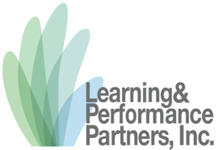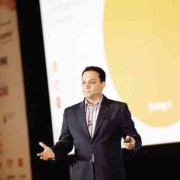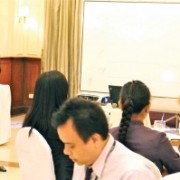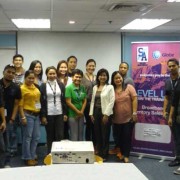Learning, applying the economics of talent
/in News /by LPPI AdminThe dynamics of today’s workplace is ever-changing. In the Philippines, this is due in large part to the boom of the business process outsourcing (BPO) industry in recent years—with its unconventional work hours and office locations, as well as its massive manpower requirements that has led to stiff competition, not just among hiring companies but among prospective employees as well.
Globally, digital technology and connectivity on the Internet has also changed the way people work. Universities and academic institutions have branched out widely into many types of specialized disciplines and skills. Thus, companies have also been scrambling to adapt to new methods to go after these talent.
Valuable commodity
The corporate world is no longer what it used to be, according to learning and development expert Armi Treñas. In her line of work in instructional design—a discipline that seeks to enhance training and learning programs—she invariably works closely with human resource managers in various corporations and firms. Thus, she is also aware of other issues that plague them, which is the hiring and retention of talent.
Progressive HR practitioners are now introducing what seems to be a radical thought, but is actually a simple but effective solution on how to tackle today’s talent management issues.
“If you think about it, the term ‘talent management’ is really just that,” poses Treñas. “Being a manager means handling resources in an effective and efficient manner. The challenge is managing talent in the truest sense of the word—and this means viewing it as a valuable commodity or a limited resource.”
Think like an economist
This is the idea behind the concept of “talent economics,” described in the seminal publication of the same title by Singapore-based human resource expert Gyan Nagpal. Having worked in HR departments of multinational organizations throughout his corporate career, Nagpal gained valuable insight into what truly drives the workforce in the 21st century.

According to him, a different look at talent management these days is that through the eyes of a business owner—talent treated as a scarce resource that is valuated, negotiated, traded and acquired. In other words, the realm of talent management has taken on the dynamics of a lucrative economy, in which companies need to be able to survive using the right strategies and tools.
Renowned global advisory Deloitte puts it succinctly in its “Human Capital Trends 2013: Leading Indicators” report: “Increasingly, many HR leaders have to answer questions that have an economic issue at their core—the allocation of a scarce resource called talent.”
This is where one of the most important ideas of talent economics comes in, and that is finding the right value that attracts the different breed of employees today. Gone are the days when one found a job and stuck to it until retirement. Jobseekers cannot be blamed as well due to the uncertain atmosphere of retrenchments, corporate mergers and acquisitions, as well as the unstable economies of even the biggest countries in the world.
Thus, HR managers are faced with tough issues that require more strategic approaches.
“They are no longer simply dealing with personnel issues,” affirms Treñas. “They should now be involved, for instance, in building a brand that will resonate with the talents they are trying to attract.”
And this involves the buy-in of the top bosses in the organization as well, in order to drive the appropriate business strategy.
Creating an environment that cultivates and retains talent is essential. Sometimes, companies get the right person but end up losing them to competition, or they hire the wrong person hoping that training can fix the problem.
Treñas knows this herself, being an instructional design expert who draws up and implements training programs.
“Learning and development is only part of the picture,” she says. “Training is not effective if the problem lies, for instance, in company systems and procedures. It is all about developing people, not just for present requirements, but with an eye toward future needs of the organization.”
Talent strategy
Treñas believes that talent economics is a valuable complement to the learning and development programs that she offers her clients. Quite fortunately, she had personally met Nagpal in the course of her regional consultancies under her firm, Learning and Performance Partners Inc. (LPPI).
She learned more about Nagpal and his pioneering theory on talent management. He has come up with a solid Certified Talent Economist (CTE) program that he is bringing to Singapore, Malaysia, India, South Africa and the United Kingdom. By next year, it is also slated to be offered in the United States and the Middle East.
It was natural that the two partnered to bring the pioneering program to HR practitioners in Manila through LPPI. Treñas says the program is recommended for CEOs and senior HR leaders—those who drive the business agenda, and those who craft and implement talent strategy to support this. Other HR and strategy consultants, as well as policymakers in government agencies, may also benefit greatly from the program.
The CTE program will tackle four key topics—business and talent strategy, diagnosing talent needs, investing in talent, and leadership engagement. All these will be implemented in learning, practice or application, and review or sharing phases.
“This design significantly increases the quality of learning and application, as compared to a traditional workshop,” explains Treñas.
Participants who complete the course will also receive perpetual and license-free use of all the tools and frameworks included in Nagpal’s Talent Economics book, as well as access to other resources such as a database of talent diagnosis questions and articles on global talent economics.
Indeed, talent economics provides exciting new hope to frustrated HR practitioners and professionals all over the world.
“Human resources professionals need to be equipped with the latest knowledge and skills on how to best select, make use of, and retain talent,” says Treñas.
The Certified Talent Economist program will be held in Manila from March 4 to 6, 2015. For more information, call (+632) 224-2020, e-mail info@learnperformance.com, or visit www.learnperformance.com.
Originally posted on: http://business.inquirer.net/182798/learning-applying-the-economics-of-talent
Advocating Learning
/in News /by LPPI AdminAsk any progressive company about their vision or business strategy, and chances are you’ll hear the words “competitive” and “competent”.
For instance, Megawide Construction Corporation Vice President for Human Resources Claudia Soriano says it’s important for them to have a competent workforce: “It’s one of the initiatives identified by the company in order for us to be more competitive in the market.”
A publicly listed company, Megawide’s projects include residential, office and school buildings, and socialized housing developments. In line with their strategic planning, top management decided on having training programs for their engineers and other technical staff. But not just any training—Soriano says they wanted it to be “as purposive as possible.” Off-the-shelf training programs just wouldn’t do.
“We wanted something that was tailor-fit to our needs,” Soriano says. “And being a construction company, kakaiba talaga ang mga needs namin (our needs are really different) from those of companies in other industries.”
Megawide called in learning strategist Armi Stephanie Treñas to help them design their training programs. The president and principal consultant of Learning and Performance Partners, Inc. (LPPI), Treñas works with companies to help make their training more effective.
It appears that in choosing customized training, Megawide is on the right track. Treñas says, “If you look at U.S. statistics, you’ll see that leading companies—the ones with more mature learning and development departments—spent 34 percent more for training.” But what’s even more telling is the fact that these companies chose to spend for customized programs compared to other companies, she adds.
Learning Architect
Treñas’ career as a learning and development practitioner spans close to 20 years. She has been in the academe and in business, working in different industries—food, construction, banking, and agriculture, to name a few. With the aim of improving business performance through customized learning solutions, she set up LPPI in 2003. The company has since served clients in the Philippines, Malaysia, China and Africa, including the United Nations and the Southeast Asian Association of Central Bankers.
“Training, for it to work, should focus on the knowledge and skills required in performance,” Treñas states. To help her clients get the most out of their learning programs, she uses a framework called Instructional Systems Design (ISD).
Ordinarily, training service providers and training programs focus on delivery rather than on the content or the design, she says. ISD is a holistic process—from analyzing a company’s requirements, all the way to evaluating whether the training met the objectives.
It’s like building a house, Treñas explains. An architect has to consider the needs, specifications, and resources of the client before designing and building a house. In the same way, instructional designers like Treñas are like learning architects who analyze and understand the learner’s requirements in the context of the business organization’s objectives.
The instructional designer then comes up with a “learning blueprint”, and identifies and develops the materials needed. The trainer comes in to execute the learning blueprint. While the instructional designer focuses on the planning side of the training, the trainer focuses on the execution. Lastly, an evaluation must be done to see if it met the training objectives and the requirements of the business organization.
Benefits Of Learning
The benefits of learning are many. “Learning can bridge competency gaps,” Treñas points out. “Companies are using training to equip graduates with the skills to make them more employable.”
One such company is EastWest Bank. The bank is on a growth path, says EastWest Academy Head Judy Capili. In 2012, they opened about 100 branches and are targeting to open 100 more in 2013.
“On any given day, we have about three training programs running. We hire about 60 to 80 people every 15 days. It’s really huge,” Capili says. “That puts a lot of pressure on us to train everyone,” she adds.
Capili explains that ISD has been useful in designing programs for new hires. With training programs skewed toward the “soft skills”, such as leadership and behavior, the tendency is that the technical aspect gets left out. “But technical skills are so important in banking, because it is a highly regulated industry,” she says.
“With ISD, training is more efficient and effective,” Capili adds. “It helps pinpoint the problem that needs to be solved, and whether it’s being solved in the best or most appropriate way,” she says.
The benefits of learning extend to Philippine business in general, says Treñas. A competent workforce helps a company’s sustainability and profitability—which in turn, contribute to the country’s general competitiveness.
An Advocacy
Treñas, who has been practicing ISD since 2001, says that LPPI is the first and only company in the country specializing in ISD. She describes her work as an advocacy.
“In essence, if we take a look at what we’re trying to do in our small way, [we are] educating the learning and development professionals as well as the client organizations. We are targeting the supply side—delivering the designing and the training—and also educating the demand side—the organizations that need the learning interventions,” she explains.
Treñas takes this advocacy a step further by offering a series of public programs starting September 24 to 27. The first one, “Foundations of Instructional Design,” imparts the basics of designing effective learning programs to help learning and development professionals analyze a situation or performance problem.
On October 16 to 17, “Evaluating Training Results” will teach participants how to assess the benefits of training. The last course on November 13 to 15 is “Train the Trainers,” in which participants learn to focus on the learner instead of the trainer for optimum learning.
“Learning is an investment,” Treñas emphasizes. “If you take a look at how learning can profoundly impact the different stakeholders, it’s like laying a foundation.”
Companies like Megawide and EastWest Bank are laying that foundation by investing in their people. “As we grow, it’s really important we have the right competencies in place,” says Capili. “That’s the reason the bank has invested a lot in learning.”
It spells not only competitiveness, but also success. “People are enablers in whatever dreams the company has.” Soriano says. “A company can have the greatest and the most ambitious vision and mission—but it’s the people who will bring it there.”
Original posted on: http://www.mb.com.ph/advocating-learning/
PH firms urged to boost investments in training
/in News /by LPPI AdminPhilippine businesses must invest in training programs to bridge the gap between education and workforce requirement, to increase the country’s competitiveness in the global arena.
“If we have an empowered, competent workforce, they can perform well and deliver the desired performance that will give [companies] the targets that [they] aspire for,” noted Armi Stephanie Treñas, president and principal consultant of local firm Learning and Performance Partners Inc. (LPPI).
“If your employees are empowered and competent, they have a sense of accomplishment. When they have a sense of accomplishment, it helps the sustainability and the profitability of the company. And if you have profitable companies, it contributes to the general competitiveness of the Philippines,” she added.
LPPI, which offers learning and development services, cited a study by Divina Edralin, a professor from the De La Salle University, which stated that Philippine companies spend a yearly average of only P1.2 million (or roughly $25,000) for training. This amount, according to LPPI, is “less impressive” compared to what US companies spend for training, which ranged from $706 per person to as much as $867 per learner.
LPPI stressed the need for training as it pointed out that “globalization, rapid growth, and the use of new technology, continue to make the business world increasingly competitive. For a company to succeed in today’s fast-paced and ever-changing business world, it must equip its personnel with the right skills and the right knowledge.”
But Treñas, who works with business organizations to make their training programs more effective, cautioned against firms conducting training “just for the sake of it.”
“Not all training can be beneficial if it is not designed properly—that is, if it is not customized to the specific needs of the learner and ultimately, the organization. Some training sessions are not related to the required knowledge or skill. Because they’re not targeted, there’s no analysis—or the analysis and the design are not interlinked,” Treñas explained.
This is why LPPI has the so-called instructional systems design (ISD), which allows companies to have their trainings customized.
Under this format, the instructional designer has to understand the learner’s requirements in the context of the business organization’s objectives.
The instructional designer then comes up with a learning blueprint, and identifies and develops the materials needed.
The next step is to execute the learning blueprint. While the instructional designer focuses on the planning side of the training, the trainer focuses on the execution.
Lastly, after the training, evaluation must be done to see if it met the training objectives and the requirements of the business organization.
Originally posted on: http://business.inquirer.net/141313/ph-firms-urged-to-boost-investments-in-training
An Effective Way to Train the Trainer
/in News /by LPPI AdminCorporate training, like any other teaching profession, calls for constant update of knowledge and skills of the trainers themselves…
http://www.philstar.com/business-life/2013/01/14/896497/effective-way-train-trainer
Architect of Corporate Learning
/in News /by LPPI AdminIf a training program runs for several months and is conducted by a famous personality, learning is bound to happen. True or false?
http://www.philstar.com/business-usual/759479/architect-corporate-learning
Why Training does not seem to work for my firm anymore
/in News /by LPPI AdminLearning can be considered a life-long process that takes place beyond the academe and extends into the corporate setting or…
Instructional design lowers cost and raises company performance
/in News /by LPPI AdminCompanies invest so much money in training, not just for the trainers’ salaries, but also for the time the employees spend attending training rather than working…
Content Analysis: Key to Excellence in your Blended Learning
/in News /by LPPI AdminAfter reviewing the current status of the training, and speaking with some of the instructional designers and trainers in different branches…







